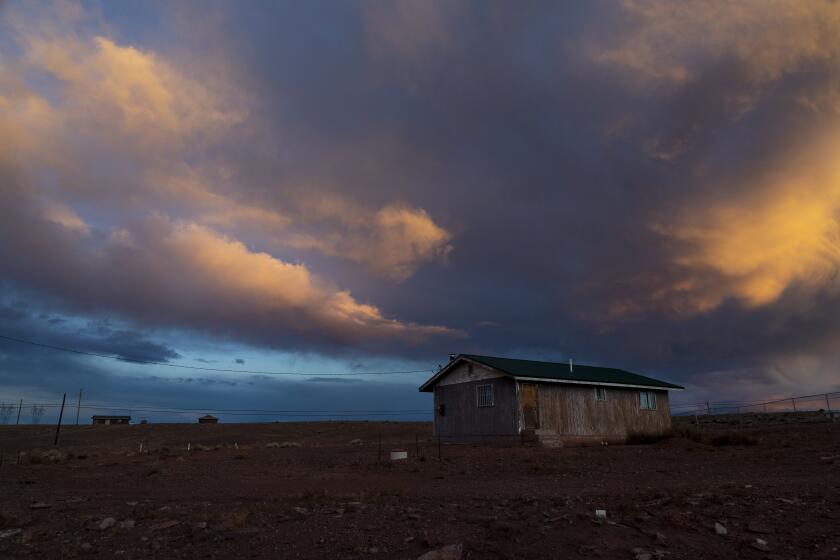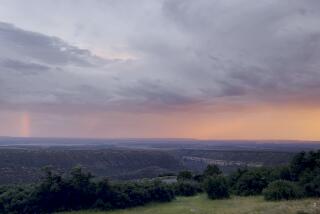On the road in the Southwest during the coronavirus pandemic. Shelter in place? Keep driving?
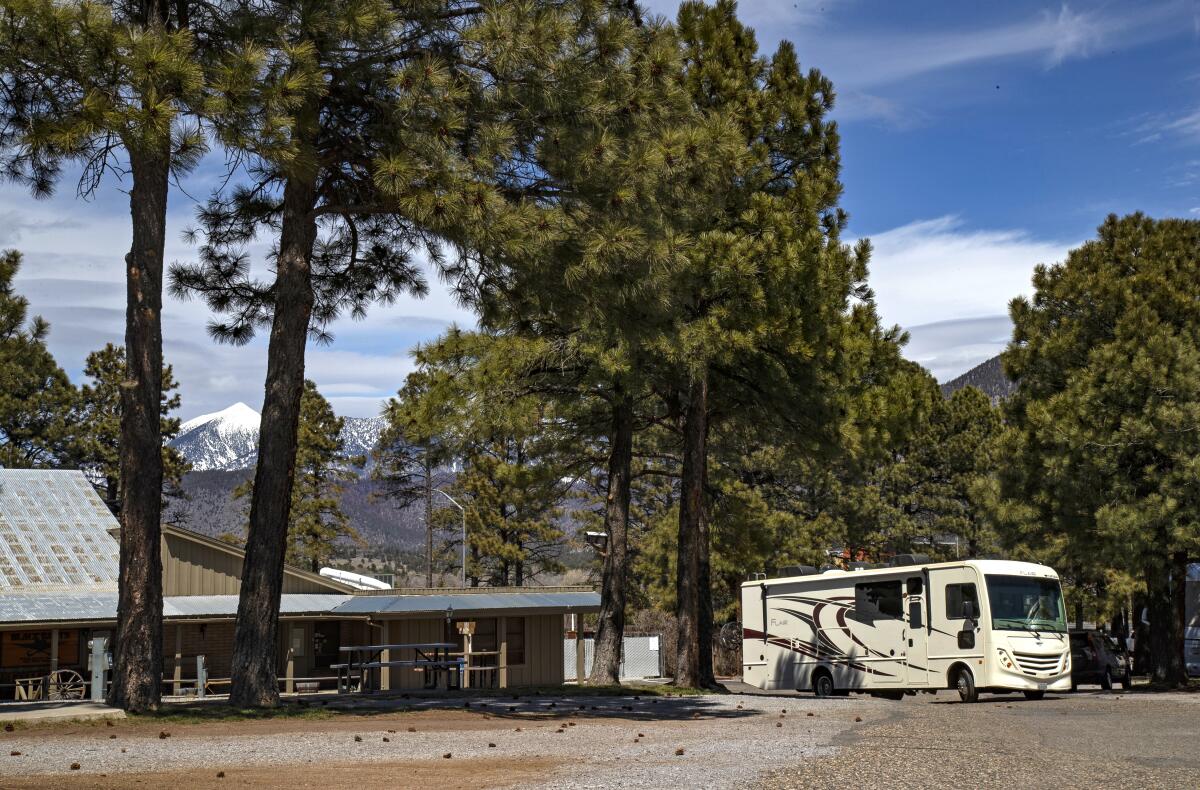
FLAGSTAFF, Ariz. — They didn’t pack masks or latex gloves before their morning hike, trusting that the increasingly empty trails amid the vast mountain vistas would provide more than adequate protection.
For R.W. Van Arsdale and his son, Robert, an impromptu respite in the Southwest has become an unlikely antidote to riding out the coronavirus pandemic.
It’s also their only option for now.
Van Arsdale’s Ford F-150 broke down two weeks ago during their father-son road trip from Oregon to the Grand Canyon. It took several days to find a mechanic who wasn’t booked up for several more days, but he finally found one and planned to be back on the road to the Pacific Northwest soon.
In the meantime, however, the pair has remained quarantined inside their travel trailer: father, son and two golden retrievers, Watson and Fink, cooped up inside a 24-foot rectangle. But Van Arsdale’s not complaining. He’s glad they have their own place in which to isolate.
“What is happening is really real and it’s terrifying,” Van Arsdale, a retired pharmacist, said one recent morning. “If people don’t take proper precautions, it can and definitely will get even worse.”
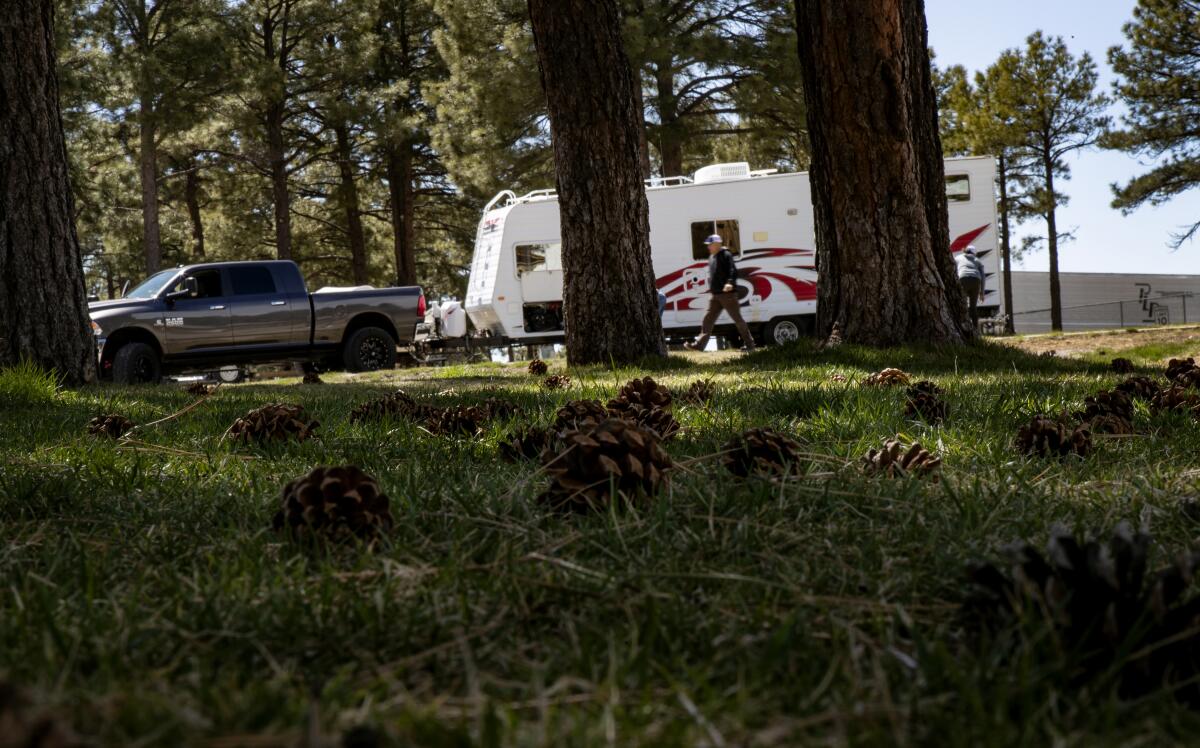
The question for Van Arsdale and other Americans traversing the country in RVs and campers this spring is what, exactly, are proper precautions during a health crisis that even a month ago — when many of them set out on their adventures along Route 66 — seemed inconceivable.
Should they pull into a Walmart parking lot and hunker down? Should they hit the open road? Or if their RV is their permanent residence, should they return to their hometown and try to find a place to park?
For now, many remain in limbo.
You can see it in the hodgepodge of motor homes and truck campers parked at Black Bart’s RV Park campground here in Flagstaff. You’ll spot license plates from North Carolina and Oklahoma, New Mexico and California, British Columbia and Alberta.
Van Arsdale, 68, and his son, 29, a graduate student at La Sierra University in Riverside, started planning their trip a year ago. Last month, after monitoring the headlines, they decided to move things up a few weeks, hoping to be home before things possibly got too dicey.
“We were going to make this a quick one,” the father said. “See the Grand Canyon and head back.”
In mid-March, they drove south on Interstate 5 from Oregon, traversing much of California before catching Interstate 40 east to Flagstaff, and then heading north to the Grand Canyon. While they hiked along the rim, more and more states started implementing stay-at-home orders, and the duo decided to head home.
“Then,” Van Arsdale said, sighing, “my truck decided to break down.”
For days, they have parked the trailer at Black Bart’s — far from the worst place to be stranded given the circumstances. Spired pine trees line the park’s gravel roads, which have names like Ambush Bend and Pony Express, and off in the distance you can see the snow-capped Humphreys Peak.
On a recent afternoon, smoke wafted through the crisp air as a fellow traveler grilled hot links for lunch.
“We’re staying inside as much as possible and following the news,” Van Arsdale said. “But we also need to step out and enjoy some fresh air.”
As a graduate student, Robert teaches English to undergraduates at La Sierra, and now that classes have moved online, he spends some of his day on Zoom, presenting slide shows and fielding questions about assignments.
“Surreal,” he said, “really, all of it is.”
And they’re far from alone in this space.
Nearly 25 million Americans traveled in recreational vehicles last spring and summer, according to a survey by the group Go RVing, which partners with the RV Industry Assn. In recent days, a blogger from New York City — the nation’s coronavirus hot spot — drew online ire when she set off on a cross-country road trip with her husband and kids inside an RV. Some believed the move was a deliberate flouting of stay-at-home orders.
“After two full weeks in the apartment, we made the family decision to drive out west so we can have a little more space,” blogger Naomi Davis wrote on Instagram, adding that they planned to take care to stay away from others.
For some families, living in their RV isn’t a back-up plan — it’s their main residence, which has made things a bit complicated.
Cody Taylor and his wife, Edith, rented out their home in Albany, Ore., about 70 miles south of Portland, last July, having decided they wanted to see more of the country before their toddler sons were school age.
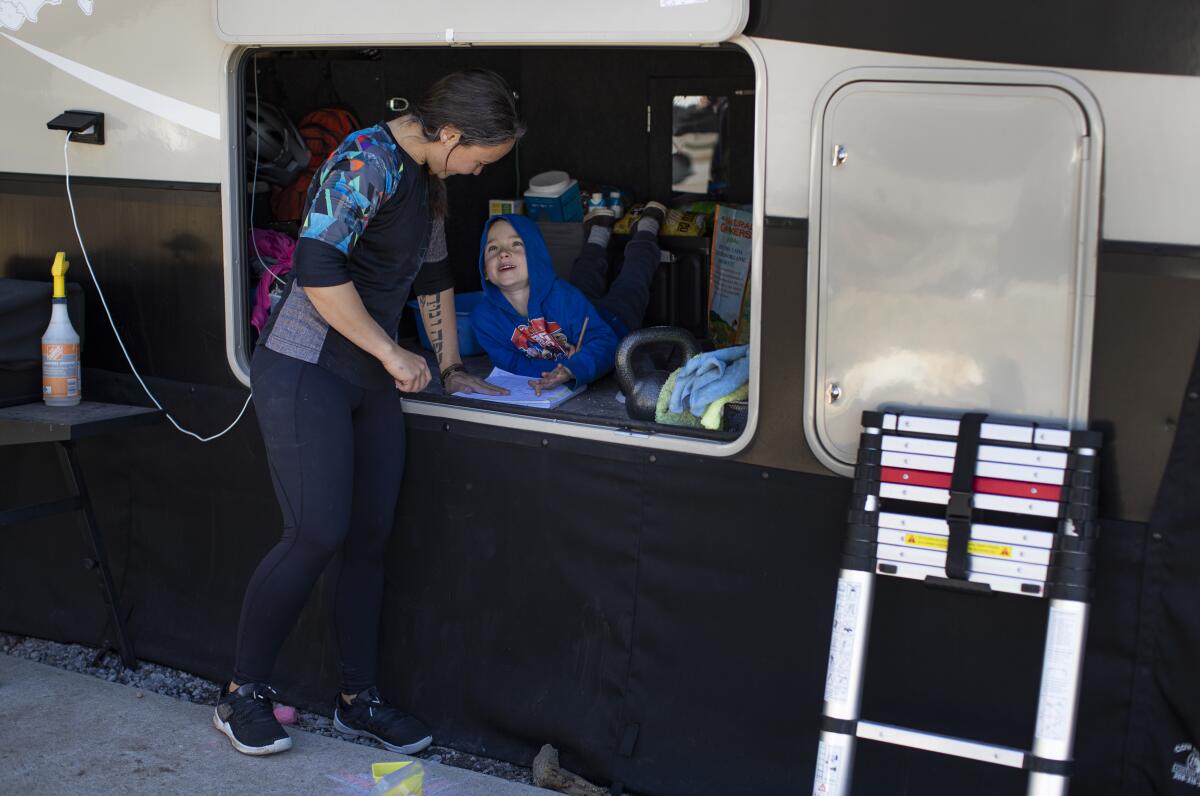
They bought a Fifth Wheel and Cody, a traveling nurse who often helps during elective surgeries, took a contract in Twin Falls, Idaho. The family lived there for several months before moving to Albuquerque for a new gig.
Five weeks ago, he began a new contract at Flagstaff Medical Center, and the family moved into Black Bart’s. Soon after President Trump declared a national emergency, the hospital ended elective surgeries, and Taylor lost his job. He’s looking for new work.
“It’s terrible,” he said on a recent afternoon as he shined the trailer attached to his pick-up truck. “But I know a lot of people are also in my situation, whether they work in a restaurant or small business.
“We just have to ride this all out,” he said.
To pass the time, the family has gone on several hikes and watches movies inside the RV. His wife, who does CrossFit workouts, managed to borrow some weightlifting equipment from a shuttered gym. She exercises often. But during their downtime, Taylor said, they ponder the future.
“I think we’re going to have to move back to Oregon soon,” he said, seated in the rear of the truck.
His wife nodded.
“It’s time to head home,” she said.
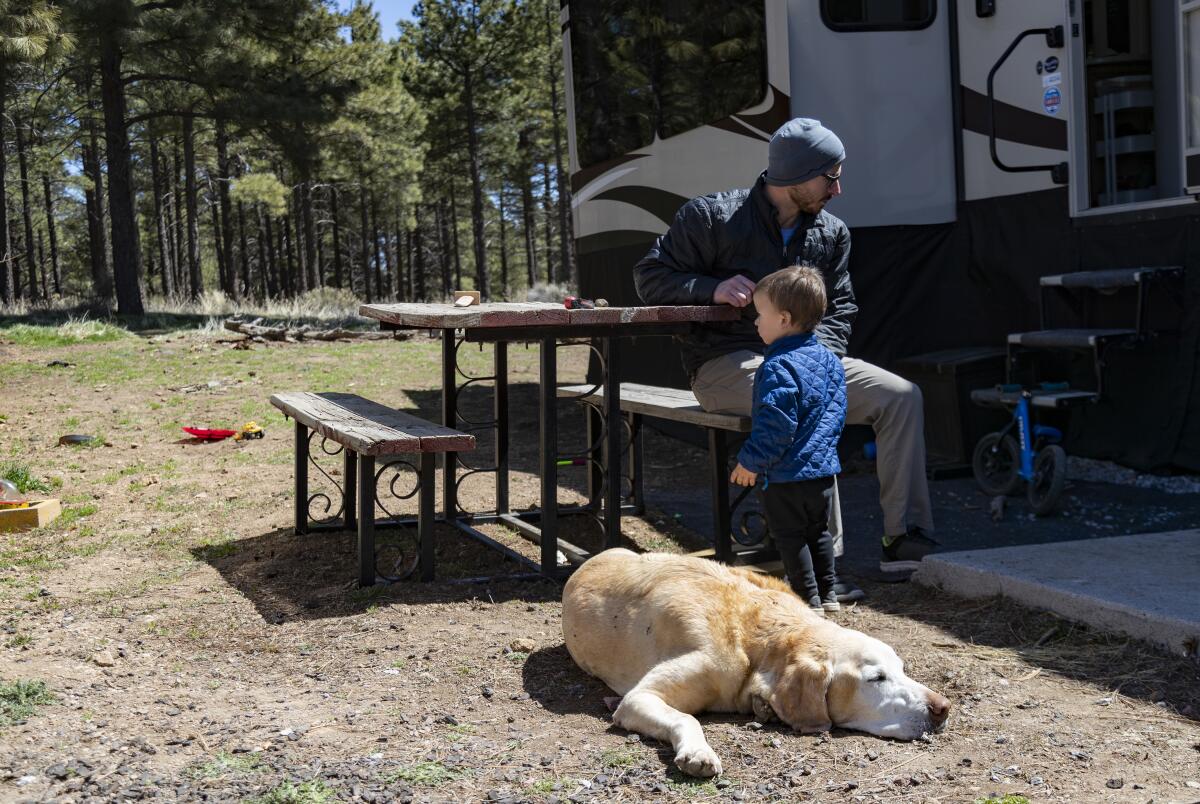
For Lawrence Dennis, Flagstaff is home.
Dennis, who lives in a Fifth Wheel across town at the Kit Carson RV Park, moved here a few years ago from Texas. During the summers, he often travels throughout the West with his wife. He’s 50 and works in insurance.
“We like to get lost in the woods and travel off the grid,” he said. “If I was actually concerned about this coronavirus, we would do that.”
Instead, Dennis said, he sees what’s going on as a massive overreaction.
“We never do this for the flu, and say what you want, this is the flu,” Dennis insisted before setting off on a two-hour bicycle ride through the nearby hills.
Dennis said he was frustrated by the order issued by the mayor of Flagstaff last week shuttering restaurants and gyms. If people want to go out to eat, he said, they should be allowed to. If they feel unsafe, he added, they can go ahead and stay home.
“It’s pretty simple to me,” he said. “The madness is just so much.”
That type of thinking concerns Van Arsdale, the retired pharmacist, who says he has had an up-close view of how quickly viruses can spread.
“The government is now taking the right steps,” he said, “I just hope we’re not too late.”
Coronavirus anxiety is running high on Navajo Nation — a sprawling reservation of 175,000 residents, scarce supplies and resources, and only four inpatient hospitals. Cases are soaring, and at least two already have died.
On a recent afternoon, Van Arsdale and his son turned north in the van they were renting while their truck was under repair, looping past a section of the Navajo Nation, which has urged travelers to stay away, as they headed toward the southern rim of the Grand Canyon.
They were greeted by a clear sky, an empty parking lot and free admission — a nearly nonexistent trio at the world wonder. (Since their visit, the park has officially closed until further notice.)
On the large plateau near the South Rim of the Grand Canyon, Van Arsdale gripped the dogs’ leashes, and Watson and Fink pulled him toward a patch of wild grass to relieve themselves.
It was beautiful here and it felt safe to be outside and in this empty parking lot.
But still, his mind was on his truck, hoping it would be fixed soon.
He just wants to go home.
More to Read
Sign up for Essential California
The most important California stories and recommendations in your inbox every morning.
You may occasionally receive promotional content from the Los Angeles Times.
